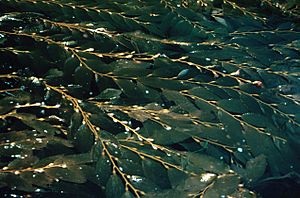Alginic acid facts for kids

Alginic acid, also known as algine or alginate, is a special kind of natural gum. It's found in the cell walls of brown algae, which are a type of seaweed. Think of it like a sticky, thick substance that helps the seaweed stay strong.
Contents
What is Alginic Acid Made Of?
Alginic acid is like a long chain made of tiny building blocks. These blocks are linked together in different patterns. Imagine a LEGO chain where you have different colored bricks. Alginic acid is similar, but its "bricks" are two types of sugar molecules. They can be arranged in groups of the same type, or they can alternate. This special structure helps alginic acid do many cool things.
Where Does Alginic Acid Come From?
Alginate that we use every day is mostly taken from different kinds of seaweed. Some common types include the giant kelp called Macrocystis pyrifera, Ascophyllum Nodosum, and various Laminaria seaweeds.
Alginate can soak up water very quickly. This makes it useful in many products. For example, it's used in things like paper and textiles (fabrics). It can also help make fabrics waterproof or fireproof. Alginate is also used to make things thick or gel-like, like in drinks, ice cream, and cosmetics. It can even help remove harmful metals from the body. Some tiny living things called bacteria, like Azotobacter species, can also make alginate.
Alginate can look different depending on how it's made. It can be white or yellowish-brown. You might find it as thin threads, small grains, tiny pieces, or a powder. It doesn't dissolve in plain water or most other liquids. However, it slowly dissolves in special basic solutions, like those made with sodium carbonate.
What is Alginic Acid Used For?
Purified forms of alginate are used in many products. For example, they are found in antacid medicines like Gaviscon® that help with stomach upset.
Alginate is also very popular for making molds. Dentists use it to make molds of teeth. Artists use it for lifecasting, which means making molds of body parts. It's also used in the food industry to make soups thicker or to create jellies. A special type called calcium alginate is used in medical products. For instance, it's used in burn dressings. These dressings help burns heal and can be removed without pain.
Because alginate is safe for the body and can easily turn into a gel, it's used to protect and hold living cells. This is important in science and medicine.
Alginic acid is also used in cooking, especially in a technique called "Esferificación" (Sphereification). A famous chef named Ferrán Adriá from El Bulli restaurant in Barcelona made this technique popular. It involves turning fruit or vegetable juices into small, soft bubbles. These bubbles "explode" in your mouth when you eat them, releasing the flavor.
See also
 In Spanish: Ácido algínico para niños
In Spanish: Ácido algínico para niños

